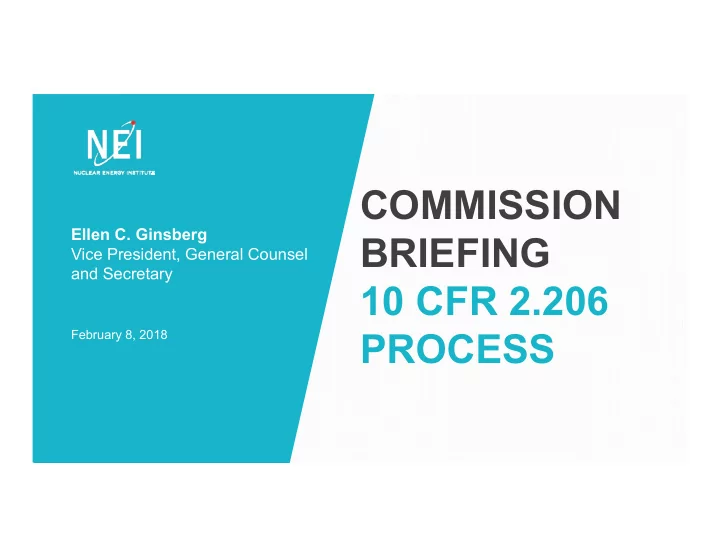

COMMISSION Ellen C. Ginsberg BRIEFING Vice President, General Counsel and Secretary 10 CFR 2.206 PROCESS February 8, 2018
SECTION 2.206 PROCESS Approach to Evaluation • Does the structure of the implementing process serve the regulation’s intended purpose? o Is there easy access/ease of use? o Are there appropriate limits/boundaries? o Are there reasonable threshold/screening and review criteria? o Is process for decision making rational? o Does data demonstrate effectiveness? o Do petitions receive appropriate NRC review and oversight? 2
SECTION 2.206 PROCESS Ease of Access and Use • The 2.206 process is available and easily used o No standing or format requirements o No requirement to mention 2.206 o Staff may even interpret petitions that do not request enforcement action as 2.206 petition • Reasonably requires factual basis for petition and relief sought o Commission or ASLB referrals screen in 3
SECTION 2.206 PROCESS Appropriately Limited • Intended use as enforcement tool is clear o Not intended to substitute for rulemaking or adjudications, allegations, OI or OIG process o Not intended to initiate NRC review if issues have been reviewed and addressed through other processes o Not intended to address general concerns o Not available if issue is not within NRC jurisdiction o Restrictions for security and SUNSI information 4
SECTION 2.206 PROCESS Reasonable Screening Criteria/Review • Management Directive 8.11 specifies rational criteria for PRB to determine whether to accept and proceed further with a 2.206 petition • Factors include: Need for immediate action, licensee response, possible consolidation, o referral to Allegation Program or OIG; adds meetings for “complex” petitions • Once accepted, process may involve review by and coordination among multiple NRC offices NRR, NRO, NMSS, OE, OGC, OI, OIG may be involved as needed o 5
SECTION 2.206 PROCESS Rational Decision-making • Assignment of petition manager to shepherd petition through process • PRB comprised of SES chair, SMEs, and if necessary, OGC, OI, OIG • PRB reviews initial staff screening; offers petitioner meeting or teleconference • Director’s Decision to include: description of issues; their safety significance; and basis for disposition Streamlined and partial decisions available options o 6
SECTION 2.206 PROCESS Notice and Opportunity to Participate • Petition manager updates petitioner of status at least every 60 days by phone or email • After PRB initial assessment, petition manager notifies petitioner whether petition meets 2.206 acceptance criteria and offers opportunity to clarify or supplement petition via a transcribed teleconference or a public meeting with PRB Petitioner may request a reasonable number of others to assist in o addressing PRB Staff and license can ask clarifying questions o 7
SECTION 2.206 PROCESS Schedule • Schedule goals in MD 8.11 include: Issue acknowledgement/closure letter within 90 days of the OEDO o assignment of the petition Issue proposed Director’s Decision for comment within 120 days o after acknowledgement letter, or less for uncomplicated petitions Issue final Director’s Decision within 45 days of the end of the o comment period • OEDO tracks schedule adherence and may extend schedule 8
SECTION 2.206 PROCESS Effectiveness • Widely-used, but often duplicates NRC Staff actions already underway o 35% of petitions lead to new NRC Staff action Petition Outcomes Number Petitions Granted In Granted, At Least In Part 95 Part Denied / Action Taken 1 51 23% Petitions Petitions Denied Denied 266 Denied/ 65% Action Taken Total (since 1975) 412 12% 1 “Denied/Action Taken” means that the NRC Staff took some action that addressed or resolved the subject of the petition. 9
SECTION 2.206 PROCESS Effectiveness • NRC action taken in 35% of 2.206 petitions filed 23% granted at least in part; additional 12% denied but NRC action taken o NRC is not required to take requested action o • Concerns in 2.206 petitions often reflect concerns detected and addressed by other NRC processes • Failure to issue most extreme relief (i.e., order) is not a reasonable measure of effectiveness • NRC should not be largely reliant on citizens to oversee safety 10
SECTION 2.206 PROCESS MD 8.11 Update • Agency should: continue to improve effectiveness, efficiency, clarity, and timeliness of 2.206 o process conduct periodic reviews and analysis o focus on quality of decision-making; ensure bases for decisions are well o documented • 2017 revisions to MD 8.11 are useful: Improved initial screening process and Petition Review Board evaluation o criteria Clarified review criteria, NRC Staff roles and responsibilities o 11
SECTION 2.206 PROCESS Additional Recommendations • A redlined version would be helpful to facilitate a close evaluation of proposed revisions • Consider retaining MD 8.11 as a single document to avoid potential confusion/inconsistencies etc. • Clarify MD 8.11 section III.D.3(c) regarding holding a petition in abeyance • Clarify timing for petition manager to notify petitioner of results of PRB initial assessment 12
COMMISSION Ellen C. Ginsberg BRIEFING Vice President, General Counsel and Secretary 10 CFR 2.206 PROCESS February 8, 2018
Recommend
More recommend